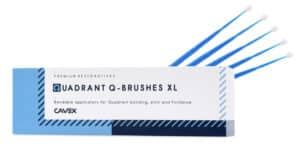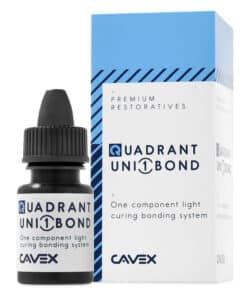Dealers
Users
General


Quadrant FiniSense
Quadrant FiniSense is a quick and effective desensitizer. The liquid provides pain relief caused by exposed dentin. Also, it relieves post-operative discomfort after crown preparation and inlays within just 30 seconds.
Quadrant FiniSense is easy to use and offers a long-lasting result. One bottle contains sufficient liquid for about 150 applications.
More information about this product? Download the brochure below. Visit our distributor’s page to discover where the product is available.
Features
- Effective within 30 seconds
- Durable 12-month effect
- Surface covering with film
- Easy to use
- About 150 applications per bottle
-
Product Photos
-
Product Photos
-
FAQ
-
Instructions For Use
-
Documents
-
FAQ
-
Why does Quadrant FiniSense contain HEMA?
HEMA ensures that the glutardialdehyde, the ingredient that closes the dentinal tubules, penetrates deeply into.
-
What happens to HEMA after application?
After application most of the excess Quadrant FiniSense will be rinsed off. The concentration of HEMA in Quadrant FiniSense is extremely low but HEMA is a methyl methacrylate monomer and can have an irritative effect.
-
Why is the usage of a cleanser to remove the smear layer before applying Quadrant FiniSense discouraged?
In the article by Lutz & Finger, “Closing of dentinal tubules by Gluma desensitizer” a cleanser is recommended, but in the article by Felton, “Evaluation of the desensitizing effect of Gluma Dentin Bond on Teeth Prepared for complete-coverage restorations” the conclusion is: “No difference was noted between teeth with smear layers intact or removed prior to treatment with Gluma”.
Our opinion is that every possible unnecessary action must be avoided, certainly with sensitive elements. -
Does the smear layer has to be removed by etching if working with Quadrant FiniSense is preferred?
No. Cleaning with, for example, pumice is sufficient. Removal by etching is only necessary if the other materials used in the treatment require it (such as a bond, for example).
-
What is coagulation?
Glutaraldehyde is a bifunctional aldehyde which can form compounds with free amino groups from the amino acids of the collagen. This clotting reaction is also called coagulation and is similar to cooking an egg.
-
Is light-polymerization necessary?
No. For Quadrant FiniSense a polymerization lamp is not required. Just apply, allow to have affect for 30 seconds and then blow-dry.
-
What precautionary measures must be taken?
Avoid contact with the gingiva and mucosa, e.g. by using a rubber dam. If contact does occur, rinse the primer thoroughly with water.
-
Does the tooth need to be thoroughly dry before application?
No. The tooth can be left slightly moist. The drying-out of exposed dentine can, however, contribute to oversensitivity and must therefore be avoided.
-
For how long does the effect of Quadrant FiniSense last?
Quadrant FiniSense has a permanent effect underneath restorative materials. Pain in the tooth-necks disappears for about 12 months.
-
How many uses can be obtained from one bottle?
Each bottle contains 5 ml. This is approx. 130 drops, sufficient for approx. 150 applications. A drop can be effective for several teeth depending on the size of the area that is being treated.
-
Is Quadrant FiniSense compatible with all restoration materials?
Yes. After applying Quadrant FiniSense any restoration material can be used.
-
Does Quadrant FiniSense need to be stored in the refrigerator?
Quadrant FiniSense must be stored at a temperature below 25°C. Storage in a refrigerator is not necessary.
-
What is the shelf-life of Quadrant FiniSense?
Quadrant FiniSense has a shelf-life of 36 months.
-
Can Quadrant FiniSense be used during teeth whitening?
Yes. Quadrant FiniSense is very suitable for eliminating sensitivity during and after bleaching of the teeth.
-
Assortment
-
Brochures
-
Product info
-
MSDS
| Art. nr. | Description | Contents |
|---|---|---|
| FS10 | Quadrant FiniSense | 1x 5 ml |
-
Product info


